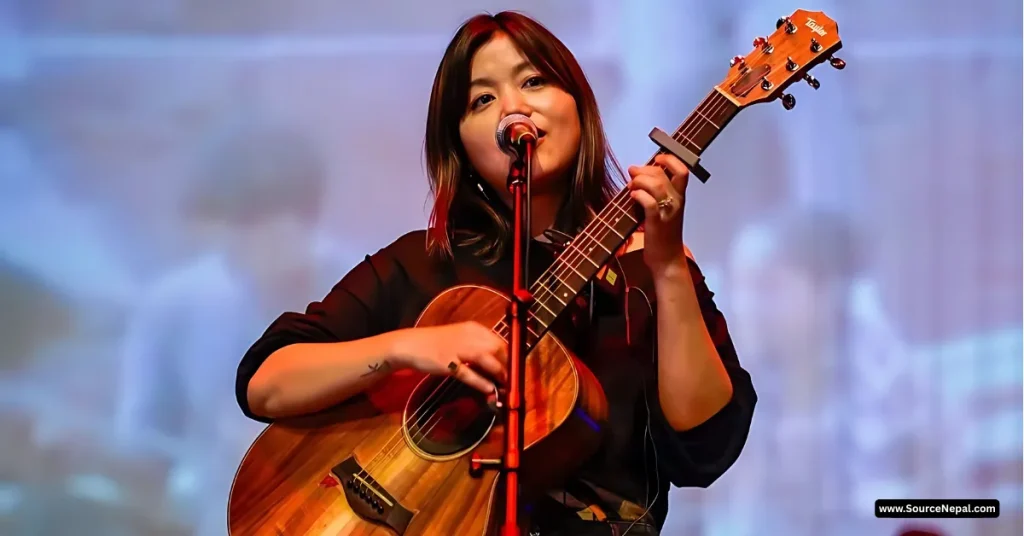In January 2016, a simple yet soul-stirring song titled “Khai” appeared on YouTube, introducing the world to Bartika Eam Rai’s unique style that would redefine contemporary Nepali music. The song quickly gained widespread popularity and was praised by The Kathmandu Post as a “breath of fresh air” for its “thrilling aesthetics of its poetry and the simplicity of its delivery.” This moment marked the arrival of a significant contemporary Nepali artist whose indie-folk and art-pop musical style would resonate deeply with both the Nepali diaspora and audiences across Nepal.
Bartika Eam Rai is a Nepali-American singer-songwriter and a prominent figure in the contemporary Nepali music scene, recognized for her poetic lyrics and distinctive indie-folk and art-pop musical style. Based in New York City, she burst onto public consciousness with the release of her debut album, Bimbaakash, in 2016. Her work explores themes of identity, longing, and introspection, bringing a fresh, modern sensibility to Nepali music while bridging geographical divides through her cross-cultural artistic identity.
Key Facts at a Glance
| Attribute | Value |
|---|---|
| Full Name | Bartika Eam Rai |
| Born | April 26, 1991 |
| Age | 34 years old (as of 2025) |
| Nationality | Nepali, American |
| Birthplace | Lalitpur, Bagmati Province, Nepal |
| Occupation | Singer-songwriter |
| Genre | Indie-folk, Art-pop, Alternative Pop |
| Active Years | 2016–Present |
| Education | Budhanilkantha School, Wesleyan College (B.S. in Accounting) |
| Notable Albums | Bimbaakash, Taral, Si/Ma-[Na], Aandhii, Ityaadi |
| Spouse | Yugal Gurung (Singer) |
| Key Collaborator | Diwas Gurung (Producer) |
| YouTube Subscribers | 312,000+ (as of mid-2025) |
Early Life in Lalitpur & Musical Foundations
Where is Bartika Eam Rai from? Bartika Eam Rai was born on April 26, 1991, in Lalitpur, Nepal, where she discovered her passion for music and writing at a young age. Growing up in the culturally rich environment of Lalitpur (also known by its Newari name, Yala), part of the Kathmandu Valley in Bagmati Province, she began pursuing music informally from age six. By eleven, she was already performing in front of small crowds at family gatherings and school events.
Her musical education began at Budhanilkantha School in Kathmandu, where she discovered her vocal abilities as a ten-year-old. Bartika Eam Rai’s mother played a crucial role in her early musical development, helping her record her debut song at fifteen and managing studio arrangements entirely on her own. The significance of family extends to her stage name—her middle name ‘Eam’ serves as a tribute to Bartika Eam Rai’s father.
After completing her SLC (School Leaving Certificate), she received formal training in Eastern vocals with renowned Nepali music teacher Gurudev Kaamat for two months. She later trained under the accomplished Shreeti Pradhan for Western vocals and learned basic piano from musician Upendra Lal Singh at Nepal Music School. This diverse musical education laid the foundation for her later fusion of traditional and contemporary styles.
During her time in Nepal’s underground music scene, she became the vocalist for the metal band Gothica in late 2010, spending a year performing with them. She gained recognition as one of the few female musicians in Kathmandu’s underground metal scene, establishing her presence before her eventual transition to indie-folk.
The American Chapter & Cross-Cultural Identity
Bartika Eam Rai moved to the United States in 2015, where she would professionally launch her music career while navigating the complexities of a cross-cultural identity. After completing her A-levels education in Nepal, she moved to the United States during her early twenties and completed her degree in Accounting at Wesleyan College in Georgia.
The transition from Lalitpur to New York City in 2015 marked a turning point in her artistic development. She began collaborating with Nepali-American musician Diwas Gurung, previously of the Ithaca-based progressive rock group Ayurveda. This partnership would prove fundamental in shaping her distinctive sound as a Nepali American indie singer creating music in New York while maintaining deep connections to her homeland.
Living in New York City provided the catalyst for her professional music career, though she has spoken candidly about the identity complexities of writing and singing in Nepali while immersed in a non-Nepali environment—a theme that would become central to her artistic expression.
Career Breakthrough & Musical Recognition
The “Khai” Phenomenon
Bartika Eam Rai released her first single, “Khai,” on YouTube in January 2016 to widespread popularity. The song became an instant hit for its soulful lyrics and simple delivery, establishing her as a fresh voice in the contemporary Nepali music landscape. For her breakthrough single “Khai,” she won Song of the Year and Best Pop Vocal Performance (Female) at the Hits FM Music Awards, marking a significant achievement for a US-based independent artist.
The success of “Khai” was remarkable not just for its immediate popularity but for how it connected with both urban Nepali youth and the global Nepali diaspora, creating a bridge between geographical and cultural spaces.
The Bimbaakash Album Success
The success of “Khai” was followed by her debut EP, Bimbaakash, a six-song collection released in March 2016. What is the Bimbaakash album? The Bimbaakash album is Bartika Eam Rai’s debut six-track EP that launched her career, featuring songs like “Khai” and “Najeek” with Rai writing and composing while Diwas Gurung produced. The EP has garnered over two million digital views on YouTube alone, solidifying her arrival in Nepal’s contemporary music scene.
Musical Style & Artistic Evolution
Defining Her Sound
What is Bartika Eam Rai’s musical style? Bartika Eam Rai’s musical style combines indie-folk and art-pop with poetry-like lyrics and distinctive vocal delivery, creating what many describe as a sophisticated approach to contemporary Nepali music. Her sound represents an innovative fusion that connects with the emotional and intellectual landscape of a new generation of Nepali listeners.
Her music is characterized by introspective themes, minimalist arrangements, and lyrics that explore abstract concepts of longing, identity, and existence. This approach has made her work particularly resonant with young, thoughtful audiences both in Nepal and among the Nepali diaspora.
The Diwas Gurung Collaboration
Her collaboration with producer Diwas Gurung has been fundamental in shaping her exclusive sonic palette. Producer Diwas Gurung’s musical expertise has enhanced Bartika’s compositions, creating the signature sound she is known for as a cross-cultural music artist. Gurung’s production work provides the sonic foundation that allows Rai’s poetic sensibilities to flourish within contemporary musical frameworks.
Complete Discography & Awards
Bartika Eam Rai has released four albums showcasing her artistic evolution:
- Bimbaakash (2016): Her debut six-track EP featuring breakthrough hits “Khai” and “Najeek”
- Taral (2018): An eight-track full-length album that further established her artistic voice
- Si/Ma-[Na] (2019): A five-track EP continuing her exploration of introspective themes
- Aandhii, Ityaadi (2024): Her latest eleven-track studio album, with songs released weekly from January to March 2024
Bartika Eam Rai awards include multiple recognitions from the Hits FM Music Awards: Song of the Year and Best Pop Vocal Performance (Female) for “Khai” at the 20th Hits FM Music Awards in 2018, and Song of the Year for “Aasha II” at the 21st Hits FM Music Awards in 2019.
Personal Life & Relationships
Marriage to Yugal Gurung
Is Bartika Eam Rai married? Yes, Bartika Eam Rai is married to fellow singer Yugal Gurung. The couple was engaged after being in a relationship for several years and later married. Bartika Eam Rai’s husband, Yugal Gurung, is a UK-based artist living in London and also serves as the drummer for the band ‘The Haami’. Both are prominent musical figures of their generation and have performed together, including at the Sofar New York City show.
Public Image & Live Performances
Bartika Eam Rai is viewed as an influential and innovative figure for Nepali youth. She is recognized as one of the few musicians who can draw similar, if not larger, reception during Bartika Eam Rai live performances as on digital platforms. She made her first music tour in Nepal in 2018, with these Nepal tours often treated as a homecoming (ghar), strengthening her connection with her audience and reinforcing her cultural roots. Her sold-out performance at the historic Patan Durbar Square in 2018 during this tour powerfully demonstrated her deep connection with local audiences and the cultural significance of her return to Nepal.
Her public persona reflects thoughtfulness and artistic integrity, qualities that have made her a role model for young Nepali artists navigating questions of identity and artistic expression in a globalized world.
Frequently Asked Questions About Bartika Eam Rai
Q: How old is Bartika Eam Rai? A: Bartika Eam Rai age is 34 years old as of 2025; Bartika Eam Rai birthday is April 26, 1991.
Q: Where is Bartika Eam Rai from? A: Bartika Eam Rai birth place is Lalitpur, Nepal, and she is currently based in New York City, USA.
Q: Is Bartika Eam Rai married? A: Yes, Bartika Eam Rai is married to singer Yugal Gurung.
Q: What are Bartika Eam Rai’s most famous songs? A: Her most famous songs include “Khai,” “Najeek,” “Aasha II,” and tracks from her latest album “Aandhii, Ityaadi.”
Q: What kind of music does Bartika Eam Rai make? A: Bartika Eam Rai creates indie-folk and art-pop music known for soulful vocals and poetic, introspective lyrics.
Q: Who produces Bartika Eam Rai’s music? A: Her music is primarily produced by Nepali-American musician Diwas Gurung, which is key to her signature sound.
Cultural Impact & Legacy in Nepal
Bartika Eam Rai has established herself as a leading figure in modern Nepali music, credited with popularizing a sophisticated indie-folk and art-pop fusion that connects with the emotional and intellectual landscape of a new generation. Her work gives voice to the cross-cultural experience, exploring themes of belonging that resonate with Nepalis worldwide.
Her success as an independent, cross-cultural artist has inspired many in Nepal’s underground music scene, proving that authenticity and artistic integrity can transcend geographical boundaries. As a songwriter known for her poetic lyrics, she has shaped a distinctive sonic palette that serves as both cultural bridge and artistic refuge for many Nepali youth.
Through her innovative approach to contemporary Nepali music and her unique position as a New York-based artist creating music rooted in Nepali sensibilities, Bartika Eam Rai has carved a permanent space in the Nepali cultural landscape. Her work demonstrates that cultural identity can be both rooted and fluid, connecting worlds through the universal language of music while maintaining deep connections to Nepali heritage and values.
Her influence extends beyond music to broader conversations about identity, diaspora experiences, and the evolution of Nepali cultural expression in a global context, making her not just a musician but a cultural voice for her generation.







